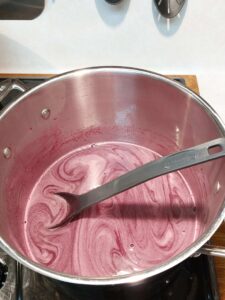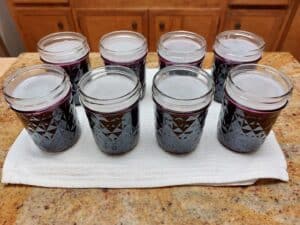I just love nice surprises, don’t you? Recently, my family had an unexpected one. We discovered mustangs in our front yard. No, not horses. I’m talking about wild Texas grapes.
The Surprise
Because I mow the yard, I knew there were “berries” growing high in a concentration of bushes and small trees in the front yard. But honestly, I never gave them a second thought until my nephew picked a bagful back in late June. He thought they were Muscadine grapes but took them to a friend for confirmation. That’s when we learned they were actually wild Mustang grapes.
Did You Know…
- There are two main types of wild grapes in Texas—Muscadine and Mustang.
- Vitis mustangensis is the botanical name for Mustang grapes.
- Mustang grapes are indigenous to Texas; parts of Louisiana, Arkansas, and Oklahoma; and southern North America.
- There is a long-standing tradition in the southern U.S., especially Texas, of hunting for and harvesting Mustang grapes. Native Americans, and later European settlers, foraged the grapes for both food and wine.
- Muscadine and Mustang grapes are both rich in antioxidants. Mustang grapes are also a good source of Vitamin C and Potassium.
Wild Grapes
I’ve heard of Muscadine grapes, but Mustang? Nope. The only Mustangs I knew—until this—were horses and cars. Now I can add wild grapes to the list.
Mustang grapes are often confused with Muscadine grapes, but they are two completely different plants. And when you know what to look for, Mustangs are easily distinguishable from Muscadines.
Clue #1: Muscadine vines spread out. Some vines can run up to 100 feet while Mustang vines have a more compact growth, climbing fence lines, trees, and shrubs, as they did in our yard. Mustang grapes are usually found on the edge of forests and in open, sunny woodlands. Though they can grow in different types of soil, they prefer sandy soil because it drains well.
Clue #2: The leaves on the Muscadine are one solid leaf shape with a few ridges around the edges and a point at the end. Mustang leaves change shapes as they mature. They begin with distinct separations, like fingers, but fill in over the summer until they look like other grape leaves. This can lead to confusion, since it looks like there are several different plants growing together. If you’re still not sure, look and feel the underside of the leaf. Muscadine leaves are green on both sides. Mustang leaves are green on the topside and silvery-white and slightly fuzzy on the underside.
Clue #3: Mustang grapes are smaller and darker than Muscadines, and they ripen in late June or early July, depending on where they’re growing. Muscadine grapes ripen August to September.
Clue #4: If you’re still not sure whether you have Muscadine or Mustang grapes, there’s one simple test that will quickly and definitely provide the answer. Taste. Muscadine grapes can be pulled off the vine and enjoyed raw. Mustang grapes . . . well, let’s just say if you bite into a raw one, its intense tartness and acidity bites back.
Let’s Cook

Mustang grapes are well-suited for jellies, preserves, desserts, and wine because of their tartness. (Our friend said he used them for wine.) Mom and I decided to try our hand at jelly making. We’re not strangers to the task, although it’s been years since we’ve made any. (As kids we picked dewberries—cousin to the blackberry—for Dad to make into jelly.) But we’ve never used Mustang or Muscadine grapes.
Our first batch of Mustang jelly was a great success. (Click here for the recipe we used.) So I willingly picked the remaining grapes.

This time, we not only made more jelly, but also a Mustang grape cobbler. (We debated about making a Mustang Pie, but the cobbler won out and was great.)
If you’re lucky enough to have wild grapes growing on your land, don’t waste them. (And if you don’t want them, give me a shout.)
Did You Know…
- You should wear gloves when handling (picking and cleaning) Mustang Grapes. The acid in the grapes and the tannins in the leaves (which deter animals from eating them) can make your hands itch and burn.
- The leaves and tendrils of both plants, when cooked, are as edible as the clusters of grapes.

